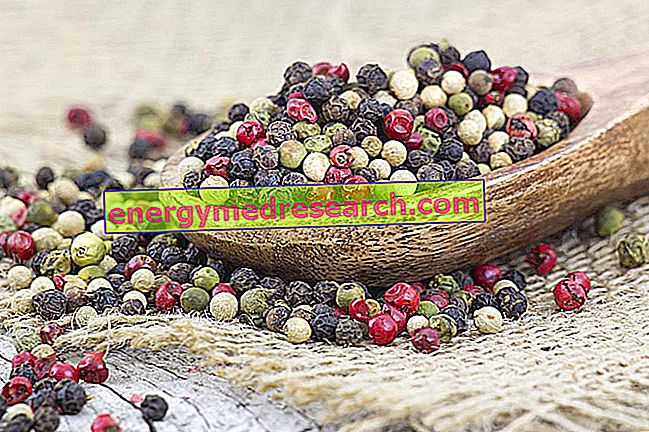What is that
The balsamic vinegar of Modena is a typical Italian food which, from 3 July 2009, enjoys the IGP recognition (Protected Geographical Indication) *.

* Note : Balsamic vinegar of Modena is NOT synonymous with "traditional" balsamic vinegar of Modena, which instead has the "Protected Designation of Origin" recognition; later we will better understand the difference.
Nutritional properties
Nutritional characteristics of balsamic vinegar of Modena
The balsamic vinegar of Modena is a product not classified in the 7 fundamental food groups. It has a moderate caloric intake, provided mainly by simple carbohydrates, consisting of glucose and fructose.
Proteins are irrelevant; fats, fibers and cholesterol appear to be absent.
Except for modest concentrations of potassium, significant levels of minerals or vitamins are not appreciated. The nutritional factors that most characterize the balsamic vinegar of Modena are different from the traditional ones; these are mainly polyphenols, as well as aromatic, volatile and non-aromatic components.
Modena balsamic vinegar can be used in any diet. Sometimes it helps to reduce the use of seasoning oil, which makes it useful in the treatment of overweight. It does not have negative aspects even for the diet against metabolic pathologies.
In significant portions it may be inadequate in the diet of those suffering from gastritis and gastroesophageal reflux disease. It has no contraindications for vegetarian, vegan and religious philosophy of any kind.
The average portion of balsamic vinegar of Modena is 5-10 g (about 5-10 kcal).
Recipes and Kitchen
Culinary uses of balsamic vinegar of Modena
The balsamic vinegar of Modena lends itself to accompany any kind of product. In all 7 basic food groups there are one or more ingredients that go perfectly with this seasoning. The most common combination is with raw vegetables and mushrooms, generally in salad or pinzimonio (with extra virgin olive oil and sea salt), and cooked vegetables, such as stewed onions. It is also widely used in all kinds of hot preparations, such as pan-based meat dishes (escalopes, medallions, strips, etc.), grilled beef steak, game stews, etc. Excellent association with certain cured meats, such as Parma ham and Culatello di Zibello. Raw pasta dishes with traditional balsamic vinegar, such as ravioli (stuffed pasta) or accompanying sauces for dried semolina pasta, are also very common.

The product also fits perfectly with oily seeds (walnuts, hazelnuts, pine nuts, etc.) and with certain fruits, such as strawberries, pears, apples, peaches, grapes and blackberries (with which you can get also special jams). Many connoisseurs appreciate boiled eggs or bazzotte and boiled fish, with particular reference to shellfish and molluscs, seasoned only with balsamic vinegar of Modena.
Description
The balsamic vinegar of Modena is a dark seasoning, tending to black, of variable consistency depending on the case. It has a characteristic taste and aroma, with a predominance of sour and sweet flavors, but they also change according to the product.
The consistency can be liquid or syrupy, the latter "usually" correlated to a higher quality level. Note : the balsamic vinegar glaze, typically denser than the NOT aged balsamic vinegar of Modena, is a completely different food and should not be confused with Modena vinegar.
Production
Overview of Modena balsamic vinegar production
The creation of balsamic vinegar of Modena takes place with the traditional system even if, depending on the producer, there are several methodological differences. To increase the possibilities of production and trade, the PGI specification is anything but restrictive, and allows the use of grape must (even if not coming from the provinces of Modena and Reggio Emilia) in percentages between 20 and 90%, wine vinegar between 10 and 80% and the use of caramel up to 2%.
On the contrary, NO picking and reinforcement steps typical of traditional DOP balsamic vinegar are required, which must comply with very strict criteria to say the least. The ingredients of balsamic vinegar of Modena, once mixed, must be stored in wooden containers for at least 60 days. If the product is aged for at least 3 years, it acquires the name of "aged".
Quality
Qualitative evaluation of balsamic vinegar of Modena
The qualitative evaluation of Modena balsamic vinegar is carried out by an independent certification body, directly appointed by the "Ministry of Agricultural, Food and Forestry Policies". The control body has the duty to verify the conformity of the food to the production disciplinary and the suitability of the final organoleptic properties; also the bottling phase, reserved exclusively for authorized and certified centers, must comply with the production regulations.
Curiosity
Consortiums of balsamic vinegar of Modena
In 1993, on the initiative of the largest and oldest producers, the "Consortium for the Protection of Modena Balsamic Vinegar" was born, with the aim of enhancing the product, protecting it and spreading it throughout the world. In 1998 the name was transformed into "Consorzio Aceto Balsamico di Modena", while maintaining the statute unchanged.
The consortium's trademark was made official in January 1999. At the same time, the "Consorzio certificated Produzione Aceto Balsamico di Modena", which in 2010 took the name of "Consorzio Filiera Aceto Betoamico di Modena", brought together some of the major producers active in the area. In 2013 these two consortia regrouped to re-form the "Consortium for the Protection of Balsamic Vinegar of Modena". Finally, among the bodies of execution and promotion, the "Committee of Independent Balsamic Vinegar of Modena" stands out which, together with the two aforementioned, was the original promoter of the request for recognition of the PGI by the European Union.
Disputes over the allocation of PGI to balsamic vinegar of Modena
After presenting the Italian application for Protected Geographical Indication for balsamic vinegar of Modena, Germany and Greece complained of a sharp reduction in national sales. They pointed out that the words "vinegar" and "balsamic", as generic terms, are not subject to protection, so they decided to recognize the PGI of the Italian product only in exchange for the right to use the terms "balsamic vinegar". France, especially due to the fact that the name "balsamic vinegar of Modena" could mislead the consumer due to the excellent reputation of the most prized "traditional balsamic vinegar of Modena".
After three years of disputes, on 3 July 2009, the European Commission included the balsamic vinegar of Modena in the register of PGIs with unanimous vote (except the abstention "technical" of France). Soon after, Greece tried to use an EU technical standard to obtain the recognition of "Greek balsamic vinegar", confirming the attraction for a market that today is worth about 400 million euros a year.



